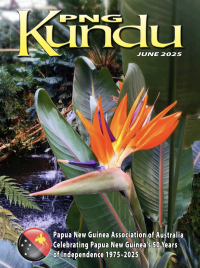Memories of the 50s in the Morobe District: Leo Butler
The 1950s in the Morobe District was a time of major growth. The construction of the Markham Bridge at Markham Point was undertaken by Hornibrooks Constructions Ltd and became a major contributor to growth. Director-General of Works, Dr Loder, and the initial Regional Works Officer, Tom Passmore, later relieved by Geoff Griffiths, were involved in achieving completion of the bridge. This bridge enabled the closure of the slow and expensive barge journey between Milfordhaven and Labu.
A protracted and bitter battle ensued between the proponents of the bridge at Kirkland’s crossing near Nadzab and those who proposed that the Bridge should be at Markham Point.
During this time Mick Leahy, a respected pioneer and explorer and a member of the Morobe DAC, was so disillusioned with the final decision that he resigned from the DAC.
With the opening of the huge Commonwealth New Guinea Timbers (CNGT) plywood mill at Bulolo, the bridge was vital. This mill was opened by Territory Minister Paul Hasluck in January 1954.
Bulolo Gold Dredging Directors AW Austin and Lars Bergstrand were on the Board, with E M Hewitt and G Gummon representing the Government.
The opening of the Plywood Mill was another project that contributed to the end of the gold era in Bulolo. The great dredges were coming to an end of their commercial life.
Contributing to the development of the timber industry, the Queensland timber firm Murdock and Murphy formed a company, South Pacific Lumber, and took up a lease in the Trans-Busu Area between the Bumbu and Bunga Rivers.
Murdock and Murphy took over Keith Noblet’s Markham Development Coy’s small sawmill.
Problems experienced with the Busu River caused difficulties with the sawmillers timber jinkers. Not to be outdone, Murdock and Murphy decided to bridge the Busu. Eventually these enterprising guys constructed a sound bridge across the Busu, much to everyone’s amazement.
South Pacific Lumber then built storage facilities at Voco Point.
The new Hotel Cecil constructed on the site of the pre-war Cecil realised Mrs Flora Stewart’s dream to re-establish a modern hotel in Lae. She was a pioneer of hotels in PNG having successfully built and operated hotels in Samarai, Wau and Lae.
Max Minahan was Mrs Stewart’s designer and overseer and also a lifetime friend, and together they achieved the construction of the new Hotel Cecil.
Horrie Niall DC was, no doubt, of assistance in obtaining the necessary approvals and progressing these to building stage as he was a great believer in the rapid development of the Morobe District.
He was also a driving force in seeing Lae and the Morobe District become a hub for progress in the surrounding area.
The Hotel Cecil’s “Bamboo Bar” was a very popular “watering hole” for many local identities of Lae and the district. One could enjoy a nice cool beer whilst listening to the many colourful pre-war and current stories of this tight community.
Mrs Stewart’s daughter, Ela, married Jim Birrell, and Flora later married Leo Bowman. Both were closely involved with the management of the Hotel Cecil.
As well, Dorothy Stewart, a relative of Mrs Stewart, also assisted.
Another development at that time was the eventual construction of a new hospital overlooking the flat which was completed in 1956.
Dr John Gunther, Director of Public Health, was involved as was District Medical Officer, Dr HB Bruce.
A further development in Lae in the early 1950s saw Vacuum Oil (Mobil) build the first Bulk Petroleum Terminal in PNG.
The terminal was designed to service both the Morobe district and the towns of Madang, Wewak, Rabaul, Kavieng, Manus and Samarai.
The 16000 ton tanker Lisford arrived at the Milfordhaven Wharf and discharged its cargo through a pipeline cut through the bush to the bulk storage tanks of the new installation in Air Corps Road.
Managers for Vacuum in those days were Charlie Heavey, Don Williams, and later Leo Bowman.
John Cooke, a pre-war veteran and a PNG Volunteer Rifles member, worked as an aviation refueller at the Lae airstrip.
Jim Huxley and wife Lee were residents of Lae and Jim ran the local newspaper. Jim was another pre-war veteran who served in the PNG Volunteer Rifles.
The Chinese community also contributed a substantial amount to the business and cultural affairs of Lae during the 50s and 60s and beyond.
Other notable personalities who were involved in the 1950’s development of Lae and Morobe District were: Arthur Ewing, Bret Bretag, Duncan Patterson, Jim Knight, John Hughes, Eric Wilson, Jim Jacobsen, George Spurrier, George Whittaker, Carl Jacobson, Bertie Heath, Bob Emery plus the Mayos brothers. Bob Bunting , Lee Ashton and Keith Noblett were prominent in establishing and promoting the development of Lae and the district. Andree Millar and husband, John, came down from Bulolo and were instrumental in the Botanical Gardens re-birth. Tom Hilliard, Jack Rice and Kevin Hilliard were transport operators along with Keith Bradford and wife Alma. Keith took over the firm Lucas and Ducrow.
This is only the tip of the iceberg in relation to people who were involved but it was a period of rapid growth which continued on into the 1970s and beyond.



